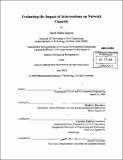Evaluating the impact of interventions on network capacity
Author(s)
Rapolu, Sujith Reddy
DownloadFull printable version (7.392Mb)
Other Contributors
Massachusetts Institute of Technology. Dept. of Civil and Environmental Engineering.
Advisor
Moshe E. Ben-Akiva and Charisma Farheen Choudhury.
Terms of use
Metadata
Show full item recordAbstract
Analyzing the capacity impact of different diverse interventions on the network is essential in understanding the causes of congestion. In this thesis, a framework to understand the effects of different disruption events and activities on the network has been presented. A common unit, independent of network and type of intervention, has been used in this regard. Expressing the capacity impacts on this common unit (referred to as 'common capacity currency' in this thesis) will be useful in assessing the relative scale or intensity of the different types of interventions across networks of different size and traffic flow levels. A network from central London, U.K. has been used to quantify the capacity impact of interventions. The network, located near Victoria station area of London, is a complex and dense urban network within the congestion charging zone. MITSIMLab, a microscopic traffic simulation laboratory developed for evaluating different traffic management systems has been used for the purpose of capacity analysis. To measure the capacity of a network in MITSIMLab, the network is flooded with vehicles by scaling the origin-destination (OD) matrix. The network is assumed to reach its capacity when pre-trip queues start forming that is no further vehicles can be loaded in the network. The total distance travelled by all the vehicles in one hour when the network has reached its capacity are noted and converted to passenger-car-unit (PCU)-km per hour. The average speeds of the vehicles at capacity are also compared. To understand the impact of interventions on network capacity, street-works and illegally parked vehicles are simulated at different levels of complexity. The common capacity. currencies (PCU-km per hour) are compared with the base case which didn't include any interventions. The results of the capacity analysis predicted a drop in network capacities and average speeds under different scenarios correctly as expected. Street-works resulted in a greater drop in network capacity and average speed than a near-side lane disruption. Further, among the scenarios tested for near side lane disruptions, a 1 minute disruption every 3 minutes caused the greatest reduction in network capacity and average speed.
Description
Thesis (S.M. in Transportation)--Massachusetts Institute of Technology, Dept. of Civil and Environmental Engineering, 2010. Cataloged from PDF version of thesis. Includes bibliographical references (p. 87-89).
Date issued
2010Department
Massachusetts Institute of Technology. Department of Civil and Environmental EngineeringPublisher
Massachusetts Institute of Technology
Keywords
Civil and Environmental Engineering.